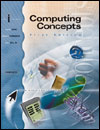 |  I-Series Computing Concepts Stephen Haag,
University of Denver
Maeve Cummings,
Pittsburg State University
Alan I Rea, Jr.,
Western Michigan University
Nuts And Bolts Of Networks And Computers
Did You KnowThe trend in computing is toward smaller, cheaper, and more powerful. And this has been so since computers began to be taken seriously in the 1960's. - The first electronic computer was 1,280 cubic feet in size. It could perform 26,000 operations per second. In contrast, a modern hand-held PDA occupies about 4 cubic inches and can perform 60,000,000 operations per second.
- From the smallest microprocessor to the biggest mainframe, the average American depends on more than 264 computers per day.
- When he got married in 1957, Dijkstra (one of the first computer gurus) listed his profession as "programmer." The authorities made him change it saying that there was no such profession.
- Nine out of 10 computers sold in the year 2000 were sold to people outside the United States.
- A 72 gigabyte hard disk has enough room to hold 12 characters (a word like "organization") for every man, woman, and child on our planet (that's over 6 billion people).
- Intel®'s Pentium 4 has _______ million transistors built into the chip.
Intel®'s Pentium 4 has 48 million transistors built into the chip. The Pentium 4 is built with Intel's 0.13-micron technology. That means that the wires are 0.13 microns wide. That's hundreds of times narrower than human hair. A single particle of talcum powder is between 20 and 30 microns across. |
|




 2002 McGraw-Hill Higher Education
2002 McGraw-Hill Higher Education